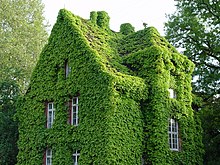Building greening
Building greening (colloquially also "house greening") is building with the inclusion of living plants, whereby these are not only design elements, but also contribute to the better functioning of buildings .
Types of building greening
For the greening of buildings one uses the roof greening , the facade greening and the interior greening .
history
The historical development of building greening can only be viewed regionally and subject-related. Of course there are many historical examples of the use of green on and in buildings, but these are usually only partially comparable with today's.
In Europe z. B. Scandinavian grass roofs or overgrown wine cellars in Austria and Hungary are well-known examples of historical green roofs. The development of current green roof systems is partly based on experience that was acquired from around 1975 with so-called "grass roofs" based on them. However, grass roofs are now considered obsolete in practice.
Facade greening is likely to have a very long tradition, since it is more often done without human intervention - preferably if it developed a protective effect or another obvious benefit ( ivy as protection from the weather, later vines as a useful plant). However, the use of climbing plants has always been an aspect of gardening and so roses , honeysuckle and clematis have probably also been cultivated on buildings in Europe since gardens were laid out here. In Africa and Asia there are references to the cultivation of climbing plants for more than 2000 years, e.g. B. in Egypt grapevines , in China Schisandra and Actinidia ( kiwi fruit ) and in Japan Japanese wisteria .
In Central Europe there have been various developments since the Middle Ages that (at times) made facade greening more popular - u. a. the growing supply of attractive climbing plants through imports from other continents, intellectual currents (e.g. romanticism ) with an impact on garden art (today landscape architecture ) and architecture (e.g. garden city movement), but also self-sufficiency in times of crisis.
For noteworthy interior greening (more than usual “flower pots”), the design of orangery structures , “palm houses” and other presentation structures for plants (see also: Botanical Garden ) can be cited as precursors.
However, the comprehensive term building greening and current processes only developed in Germany in the last quarter of the last century. With the first handbooks on organic architecture by Rudolf Doernach in 1974, plant architecture was scientifically developed. Today, building greening is a recognized means of upgrading both individual buildings and building areas, and they are integrated into ecological construction . Techniques and processes have been specifically developed since around 1975 that meet the increasing requirements in terms of functions and quality.
Specifications for roof and facade greening are now part of numerous progressive development plans, u. a. for redevelopment areas (cf. area redevelopment , redevelopment of urban wastelands) or industrial parks . There are funding programs in many places.
Use

Greening buildings can increase their aesthetic value and reduce the environmentally harmful effects of building (including surface sealing ). Outside sided roofs act locally beneficial to the micro- climate (especially temperature, humidity) and can - a certain degree of greening provided - even Stadtklimate measurably improve. Buildings with greenery on the outside benefit from physical building advantages, which - also taking into account the maintenance of greenery - can reduce costs due to the extension of renovation intervals through protective effects.
Indoor greening is used in particular in large (partially) public spaces for structuring, e.g. B. dividing space or leading away. It also serves to dampen noises ( room acoustics ). The interior is felt to be more pleasant due to the increased humidity due to natural evaporation.
Every green building (outside and inside) reduces the pollutant content of the air . This air hygiene aspect also deserves special attention with regard to fine dust .
literature
- Walter Kolb, Tassilo Schwarz: Green roofs - intensive and extensive . Eugen Ulmer, Stuttgart 1999, ISBN 3-8001-5075-1 .
- Manfred Köhler, Georg Barth, Thorwald Brandwein: Facade greening and roof greening. Eugen Ulmer, Stuttgart 1993, ISBN 3-8001-5064-6 .
- Bernd W. Krupka: Roof greening. Use of plants and vegetation on buildings . (Handbook of landscaping). Eugen Ulmer, Stuttgart 1992, ISBN 3-8001-5051-4 .
- Federal Agency for Nature Conservation (BfN): Roof and facade greening - new habitats in the settlement area. Facts, arguments and recommendations. Bonn 2019, ISBN 978-3-89624-276-1
- Roof + green. Trade magazine for building greening. Roof, facade, interior. 4 issues a year, published since 1992. Verlag Dieter A. Kuberski, Stuttgart, ISSN 0943-5271
- FLL: Instructions for the care and maintenance of green roofs , Bonn 2002 Reference + Info ( page no longer available )
- FLL: Guideline for the planning, execution and maintenance of green roofs , Bonn 2008 Reference + Info ( page no longer available )
- FLL: Guideline for the planning, execution and maintenance of facade greening with climbing plants . Bonn, 2000 reference + info ( page no longer available )
- FLL: Guideline for the planning, execution and maintenance of interior greening , Bonn 2011 reference + info ( page no longer available )
- Nicole Pfoser / Nathalie Jenner et al .: Green building energy. Potentials and interactions. Final report on the future construction research project, ISBN 978-3-940122-46-9 , free download ( page no longer available ).
Web links
- fbb.de - Fachvereinigung Bauwerksbegünung eV
- worldgreenroof.org - Site of the World Green Infrastructure Network
- Zukunft Bau research initiative: Final report “Greening Energy Buildings. Potentials and interactions. " ( Page no longer available )
Individual evidence
- ↑ Rudolf Doernach: Biotektur. Wildberg 1974
